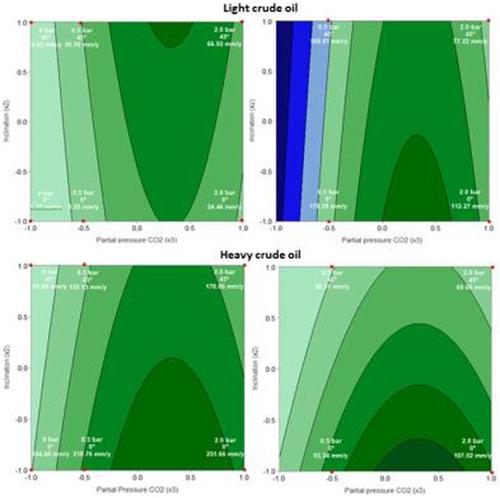当前位置:
X-MOL 学术
›
Mater. Corros.
›
论文详情
Our official English website, www.x-mol.net, welcomes your
feedback! (Note: you will need to create a separate account there.)
Prediction models for multiphase-flow-induced corrosion of API X80 steel in CO2/H2S environment
Materials and Corrosion ( IF 1.6 ) Pub Date : 2021-07-16 , DOI: 10.1002/maco.202112451 Carlos A. Silva 1, 2 , Henrique B. Pereira 2 , Maria E. S. Taqueda 3 , Zehbour Panossian 1
Materials and Corrosion ( IF 1.6 ) Pub Date : 2021-07-16 , DOI: 10.1002/maco.202112451 Carlos A. Silva 1, 2 , Henrique B. Pereira 2 , Maria E. S. Taqueda 3 , Zehbour Panossian 1
Affiliation

|
In the offshore oil and gas industry, mainly focusing on the use of rigid or flexible pipes of subsea infrastructure applied to risers or flowlines, one of the greatest difficulties is the interpretation of the combined effects of the various correlated phenomena (hydrodynamic effects of intermittent flow, the effects of corrosivity of the environment in addition to variations in pressure, temperature, and dynamic loading). On the basis of this scenario, defining the degree of severity of each of the correlated system variables becomes of fundamental importance for establishing reliable criteria for selecting materials for subsea application. The established flow pattern directly affects the corrosion rate (or the pipe material mass loss), but the balance of other variables including possible changes in the physical and transported fluid chemical properties may increase the damage up to an order of magnitude, which is a piece of information normally not foreseen in design criteria. Therefore, to improve the understanding of the corrosion study influenced by multiphase flow, a testing loop was designed and assembled at the Corrosion and Protection Laboratory of the Institute for Technological Research, in which API X80 steel coupons were positioned in locations with a 0° and 45° inclinations. Tests were conducted by varying the partial pressure of the gaseous phase containing blends of CO2 and H2S with N2 balance, mixed with the liquid phase containing light oil and heavy oil in water with salinity (NaCl)-simulating oil well conditions with 80% water cut. The main objective of this study is to establish models that can predict the corrosion intensity in conditions close to those obtained experimentally. To achieve results, the multiple regression and Box–Cox transformation methods were applied. These models will make possible damage prediction and optimization of matrix parameters for the multiphase-loop test.
中文翻译:

CO2/H2S环境下API X80钢多相流腐蚀预测模型
在海上石油和天然气行业中,主要关注应用于立管或出油管的海底基础设施刚性或柔性管道的使用,最大的困难之一是解释各种相关现象的组合效应(间歇流动的流体动力效应)。 、环境腐蚀性的影响以及压力、温度和动态载荷的变化)。在这种情况下,定义每个相关系统变量的严重程度对于建立选择海底应用材料的可靠标准至关重要。已建立的流型直接影响腐蚀速率(或管道材料质量损失),但其他变量的平衡,包括物理和输送流体化学特性的可能变化,可能会将损坏增加一个数量级,这是设计标准中通常无法预见的一条信息。因此,为了提高对多相流影响腐蚀研究的理解,在技术研究所腐蚀与保护实验室设计并组装了一个测试回路,其中 API X80 钢试样被放置在 0°和45° 倾角。通过改变含有 CO 混合物的气相的分压来进行测试 为了加深对多相流影响腐蚀研究的理解,在技术研究所腐蚀与保护实验室设计并组装了一个测试回路,其中 API X80 钢试样放置在 0° 和 45° 的位置倾向。通过改变含有 CO 混合物的气相的分压来进行测试 为了加深对多相流影响腐蚀研究的理解,在技术研究所腐蚀与保护实验室设计并组装了一个测试回路,其中 API X80 钢试样放置在 0° 和 45° 的位置倾向。通过改变含有 CO 混合物的气相的分压来进行测试2和 H 2 S 与 N 2平衡,与含轻油和重油的液相混合,含盐度(NaCl)-模拟含 80% 含水量的油井条件。本研究的主要目的是建立模型,可以在与实验获得的条件接近的条件下预测腐蚀强度。为了获得结果,应用了多元回归和 Box-Cox 变换方法。这些模型将使多相回路测试的矩阵参数的损坏预测和优化成为可能。
更新日期:2021-07-16
中文翻译:

CO2/H2S环境下API X80钢多相流腐蚀预测模型
在海上石油和天然气行业中,主要关注应用于立管或出油管的海底基础设施刚性或柔性管道的使用,最大的困难之一是解释各种相关现象的组合效应(间歇流动的流体动力效应)。 、环境腐蚀性的影响以及压力、温度和动态载荷的变化)。在这种情况下,定义每个相关系统变量的严重程度对于建立选择海底应用材料的可靠标准至关重要。已建立的流型直接影响腐蚀速率(或管道材料质量损失),但其他变量的平衡,包括物理和输送流体化学特性的可能变化,可能会将损坏增加一个数量级,这是设计标准中通常无法预见的一条信息。因此,为了提高对多相流影响腐蚀研究的理解,在技术研究所腐蚀与保护实验室设计并组装了一个测试回路,其中 API X80 钢试样被放置在 0°和45° 倾角。通过改变含有 CO 混合物的气相的分压来进行测试 为了加深对多相流影响腐蚀研究的理解,在技术研究所腐蚀与保护实验室设计并组装了一个测试回路,其中 API X80 钢试样放置在 0° 和 45° 的位置倾向。通过改变含有 CO 混合物的气相的分压来进行测试 为了加深对多相流影响腐蚀研究的理解,在技术研究所腐蚀与保护实验室设计并组装了一个测试回路,其中 API X80 钢试样放置在 0° 和 45° 的位置倾向。通过改变含有 CO 混合物的气相的分压来进行测试2和 H 2 S 与 N 2平衡,与含轻油和重油的液相混合,含盐度(NaCl)-模拟含 80% 含水量的油井条件。本研究的主要目的是建立模型,可以在与实验获得的条件接近的条件下预测腐蚀强度。为了获得结果,应用了多元回归和 Box-Cox 变换方法。这些模型将使多相回路测试的矩阵参数的损坏预测和优化成为可能。











































 京公网安备 11010802027423号
京公网安备 11010802027423号